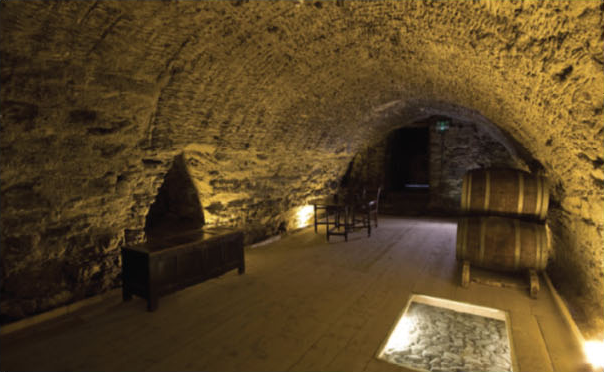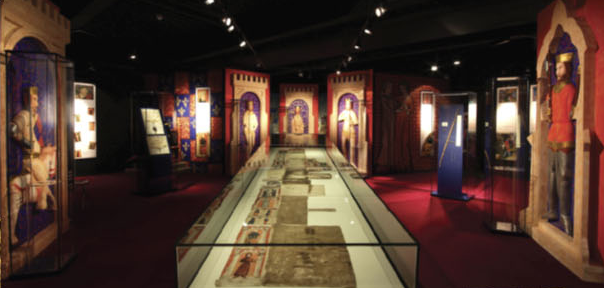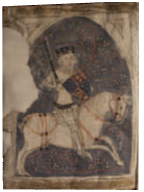Museum eye: Waterford Museum of Treasures: Medieval Museum
Published in Issue 1 (January/February 2014), Reviews, Volume 22museumreception@waterfordcity.ie, www.WaterfordTreasures.ie
+353 (0)51 304500
by Tony Canavan

The tour begins underground in the medieval vaults, which have northern Europe’s only intact wickerwork vaulted ceiling.
The Waterford Museum of Treasures, established in the 1990s, has been expanded into a three-campus concept focusing on different eras in the city’s history. Located in the recently designated Viking Triangle, Reginald’s Tower looks at the Vikings; the Medieval Museum is self-explanatory, and the Bishop’s Palace concentrates on the Georgian period. The Medieval Museum is Ireland’s first purpose-built museum dedicated to this period.
The museum itself is simple in design. Built over the medieval mayor’s vaults and Choristers’ Hall, it consists of three floors. The ground floor houses the reception and gift shop, while the upper floors each consist of an exhibition gallery, theatre and a ‘void’ which serves as a vestibule to that floor.
It can take up to four hours to cover the entire museum and with the option of an audio guide, but I recommend going on one of the guided tours, which last about an hour. A local takes you through the exhibitions, pointing out the highlights among the exhibits and telling stories attached to the various objects. Our guide gave us a lively and entertaining, if not always accurate, account of Ireland’s history and Waterford’s part in it. The city claims to be the oldest in Ireland, dating back to AD 914, although that depends on how you define a city and/or Ireland. Nevertheless, its antiquity and key role in Irish history cannot be denied.

The exhibits are a feast for the eye and the imagination. Life-size effigies of the various kings fill the room alongside models of the city at various stages of development.
The tour begins underground in the medieval vaults, which have northern Europe’s only intact wickerwork vaulted ceiling. Our guide explained that the city’s history was concerned with ‘religion, war and money’, as he explained the city’s Viking origins, the religious buildings that stood on this site and Waterford’s growth as a trading centre. Not only was it for hundreds of years the premier port for bringing wine into Ireland but it also became important for coffee in the seventeenth century. The tour then leaves the Choristers’ Hall to go upstairs into the museum itself.
For a purpose-built modern museum there is relatively little in the way of hi-tech gimmickry or interactive displays. Each floor has videos that introduce the history and the exhibits and there are the audio guides; activity sheets are available for younger visitors. On the whole, however, the museum allows the artefacts to speak for themselves and, considering the kind of artefacts it has, this is understandable.
The galleries address two themes: the royal and the religious. The upper floor, while ostensibly about life in medieval Waterford, is really about its relationship to the English crown. From the time when Henry II made it a royal city, Waterford remained true to successive English kings and queens. Indeed, one leaves the gallery with the impression that the city does not consider itself Irish at all. Rather detailed information panels adorn the walls relating the events from Henry II to William III, outlining the royal succession and what charters or patents each king granted to the city.

In the glass case in the centre is the Great Charter Roll, which bears painted images of kings such as John and Edward III (right) and various justiciars of Ireland.
The exhibits themselves are a feast for the eye and the imagination. Life-size effigies of the various kings fill the room alongside models of the city at various stages of development, while the display cabinets have wine jugs, weapons (ceremonial and combat), jewelry and original documents. Worth mentioning are Ireland’s only surviving example of a medieval half-bow, the famous Waterford brooch, the New Ross silver mace, and a cap of maintenance that belonged to Henry VIII. The latter is the only surviving piece of clothing from a Tudor monarch anywhere in the world. All the labels on the displays are in Irish, English, French and German.
Among the various parchments and scrolls, pride of place goes to the Great Charter Roll. This consists of the various charters granted to the city up to 1373. It is an impressive illustrated document bearing painted images of kings such as John and Edward III and various justiciars of Ireland. It was brought together to settle a dispute with New Ross over who had prevailing commercial rights on the river and was meant to prove the superior status of Waterford, based on its special relationship with the English crown. It is both a legal document and a piece of propaganda.
Downstairs is the second gallery, which represents the city’s Christian heritage. Like the previous one, this gallery has panels depicting history, various documents, such as a rent roll, and artefacts, like a unique seventeenth-century Spanish chest. The ecclesiastical history is depicted through models, objects and documents, which convey how important a role the church played in the city both before and after the Reformation.
The main purpose of the area is to show the set of six ecclesiastical vestments that once belonged to Waterford cathedral. The story of how they were lost for centuries and found again is a fascinating one. Buried for safe keeping under the old cathedral during Cromwell’s siege, they were rediscovered in the eighteenth century when the medieval building was being demolished to make way for the current Church of Ireland cathedral. Dating from the fifteenth century, they represent the work of master craftsmen from Florence and Flanders, the former to make vestments using actual threads of gold, and the latter to decorate them with embroidered religious scenes. This is the only complete set of pre-Reformation vestments to survive in these islands. It consists of four copes and two High Mass robes. On the vestments are depicted saints such as James, Gregory and Agnes, as well as scenes from the life of Christ. Placed in a side gallery of their own, each in its own carefully lit cabinet, these are truly magnificent garments.
Once the guided tour is over, the visitor is free to go back and examine in detail the two galleries. This is well worthwhile as there is a wealth of material to see and a lot of reading to do. I recommend this museum not only for its design and content but also for capturing the essence of Waterford as a historic city and as an exercise in civic pride. HI
















